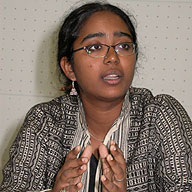An Interview with Kalpana Subramanian
The Process of Searching Is the Important Thing

Q: What were the circumstances behind making this piece?
KS: This piece is part of the Crossing Project, a multimedia exhibition about Banaras. It was made at the Sacred World Foundation, where I’m working now. The aim of Ranjit Makkuni, the Sacred World Foundation director and producer of this film, is to find innovative methods using new technology like computers and multimedia to more interactively convey information about culture, spirituality and tradition. He chose Banaras as the place to try this out. I thought out the content of this project with him, and I produced several exhibitions on location. This project has won an international design award.
Q: How did the shooting go?
KS: The shooting was done with a team of three people, and I was in charge of the camera. It was important for me to hold the camera. Since the very progress of the piece took shape depending on what kinds of people we encountered, if I had the camera and I wanted to shoot or talk with a certain person, I could immediately point the camera in their direction. I think it was a very sensual and improvised approach.
Q: Did you get lost during the shooting too?
KS: Yes, all the time (laughs).
Q: It’s really intriguing how viewers also can get a sense of wandering through a maze, but how did you create this effect?
KS: There wasn’t any script for the shoot, so during the shooting the important thing was just to go on shooting and to encounter different people while getting lost in the city, not knowing what would happen. During the editing, I found connections among the people, places and events within myself while reviewing the large quantity of footage that was shot, and I linked it together so it became a single piece. I brought it together into a single piece based on free and artistic inspiration, rather than using a format of recreating things that had actually happened. That was a really enjoyable process.
Q: I had doubts about where the destination was in the piece, but did you shoot with a destination in mind?
KS: I picked three places in advance for the shoot. First we’d head for one place, asking people on the street for directions and getting lost along the way, and when we arrived we set off for the next place. Finally during the editing I decided not to reveal the destinations where we arrive. Because the important thing is not the destination, but the process of searching.
Q: You’ve said there are lots of things you’d like to shoot about Banaras, but have you decided your next project?
KS: I haven’t decided exactly, but basically I’m interested in the “flavor of cities.” You can’t really understand a city from looking at a map, and the people who live there are the ones who really know the place. For example, when I pass by a certain house I might just think it’s a house with pretty windows, but when people who live there pass by, it might mean something like “Ah, this is a house where so-and-so lived three hundred years ago, where these things happened.” Each and every stone and wall in a city has its own meaning. I am very interested in finding that kind of “city hidden within the real city.” Banaras has a history of over three millennia, but it’s a city that continues living today, not a place that has turned into a monument.
(Compiled by Yokota Yuri)
Interviewers: Yokota Yuri, Matsumoto Miho / Interpreter: Kaneko Yoshiya
Photography: Sato Akari / Video: Kato Takanobu / 2003-10-11
